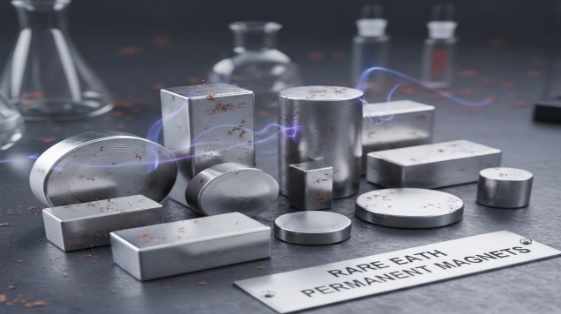(Prelims: Important Schemes and Programs)
(Mains, General Studies Papers 2 and 3: Government policies and interventions for development in various sectors and issues arising from their design and implementation, Science and Technology – Developments and Applications and their Impact on Everyday Life) |
Context
The Union Cabinet recently approved a new scheme with a financial outlay of ₹7,280 crore aimed at promoting the domestic manufacturing of sintered rare earth permanent magnets (REPM) in India.

About Sintered Rare Earth Permanent Magnets
- Sintered rare earth permanent magnets are the most powerful permanent magnets made from alloys of rare-earth elements such as neodymium and samarium. Sintering is a manufacturing process in which powder is heated and compressed to form a solid magnet.
- This includes the conversion of rare earth oxides into metals, metals into alloys, and alloys into REPM. This scheme, approved by the Cabinet, will facilitate the establishment of integrated REPM manufacturing units.
- The key features of REPM include high magnetic strength, high heat resistance, compact size with superior performance, and the absence of viable alternatives for high-performance applications.
What is the REPM Ecosystem?
- The REPM ecosystem refers to the entire industrial infrastructure that includes the conversion of rare earth oxides into metals, the preparation of alloys from metals, and the production of high-quality permanent magnets from those alloys. This is the first national initiative of its kind, in which a complete domestic supply chain will be developed.
- This initiative aims to create a domestic supply chain to convert NdPr (neodymium-praseodymium) oxide into high-performance sintered NdFeB (neodymium-iron-boron) magnets. These are widely used in electric vehicles (EVs), wind turbines, aerospace and defense applications, consumer electronics, and medical imaging equipment, as REPMs are considered the world's most powerful and efficient magnets.
- NdFeB magnets, in particular, are the most powerful commercial magnets available globally, made by sintering rare-earth-based alloys such as neodymium-iron-boron.
- A typical mid-size electric car requires 1-2 kg of NdFeB magnets, while a 3-MW offshore wind turbine requires approximately 600 kg.
About the REPM Scheme
- This Cabinet-approved scheme aims to establish integrated REPM manufacturing plants with a capacity of 6,000 MTPA (metric tons per annum) in India.
- The scheme has a total financial outlay of ₹7,280 crore, which includes a sales-based incentive of ₹6,450 crore on REPM sales over five years and a capital subsidy of ₹750 crore to establish integrated rare earth permanent magnet (REPM) manufacturing units in India producing 6,000 metric tons per annum.
- Its implementation will be overseen by the Ministry of Heavy Industries in collaboration with the Department of Atomic Energy, Ministry of Mines, and NITI Aayog.
Key Points
- Under this scheme, for the first time, a complete integrated REPM production chain will be established in India, from oxide to finished magnets.
- A total of 5 beneficiaries will be selected through Global Competitive Bidding.
- Each beneficiary will be allocated a maximum capacity of 1,200 MTPA. The total duration of the scheme will be 7 years, including a 2-year setup period and a 5-year incentive period.
Current Situation in India
- India has 6.9 million tonnes of REE reserves, the fifth largest globally. Despite this, its contribution to global production is approximately 1%. Currently, almost all of India's REPM demand is dependent on imports.
- China controls approximately 90% of global REPM supply.
- With India's target of 30% electric vehicle penetration by 2030 and rapid growth in renewable energy capacity, REPM demand is expected to double by 2030.
- The most viable sources of rare earth minerals are mostly in South India. Kerala has the largest monazite belt. These are particularly concentrated in the Kollam-Alappuzha-Kanyakumari region, where Indian Rare Earths Limited operates large plants in Chavara and Manavalakurichi.
- Odisha's Ganjam, Balasore, and Mayurbhanj districts, especially the Chhatrapur Mineral Sand Belt, are estimated to have over three million tonnes of heavy mineral resources. Andhra Pradesh's coastal zones, including Srikakulam, Visakhapatnam, and the Krishna-Godavari belt, as well as Tamil Nadu's Tuticorin, Tirunelveli, and Kanyakumari districts, are also sources.
Key Features
- For the first time, a fully integrated manufacturing infrastructure for REPM will be established in the country.
- The scheme will strengthen the Atmanirbhar Bharat Abhiyan and support the goal of a developed India @ 2047.
- The project will strengthen the supply chain of high-tech industries such as electric vehicles, renewable energy, electronics, defense, and aerospace.
- Incentives will be directly linked to the sales of manufactured magnets, encouraging industries to increase production.
- REPM manufacturing will promote new technology, research, skills, and employment generation.
- India will be established as an emerging force in the global REPM market.
|
Did you know?
- Monazite is a reddish-brown phosphate mineral rich in rare earth elements (such as cerium, lanthanum, and neodymium) and thorium, often found in beach and river sand.
- Separating the 17 different rare earth elements requires hundreds of stages of solvent extraction, which uses excessive acid and produces highly toxic and radioactive waste. Producing one ton of rare earth oxides can produce 70–100 tons of hazardous tailings.
|



